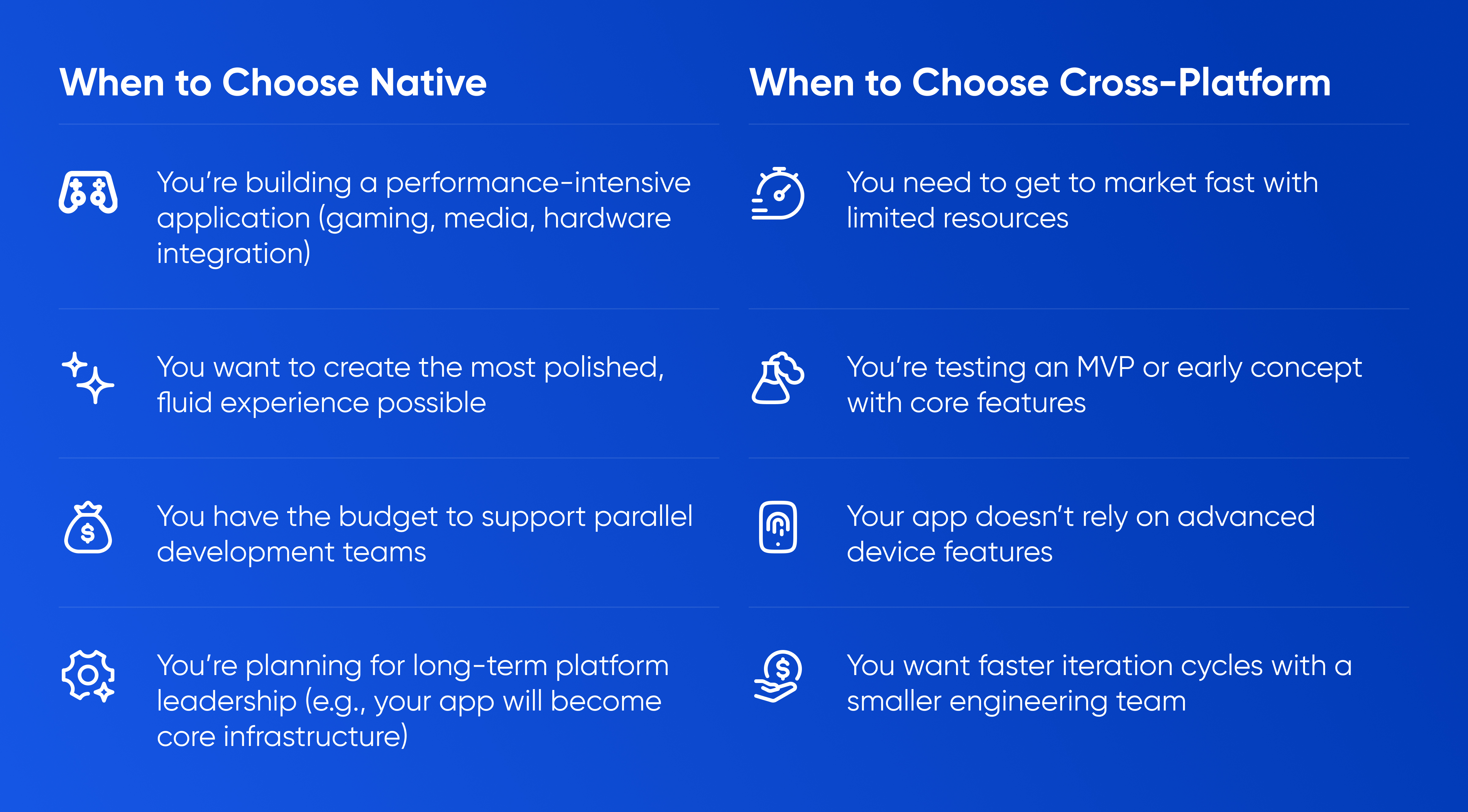When you're building a new mobile app, the first big technical decision can feel deceptively simple: should you go native or choose a cross-platform solution? But beneath this choice lies a series of trade-offs that affect your speed, budget, team composition, user experience, and long-term scalability.
Founders often come to us with a strong vision for their product but limited clarity on the implications of each path. They’ve heard buzzwords like Flutter, React Native, Kotlin, Swift, performance, maintainability — but aren’t always sure how those pieces fit into their business strategy.
So let’s unpack it. Native and cross-platform development are not enemies. They are tools. And like any tool, the best one depends on the job you’re trying to do.

What Is Native Development?
Native development means building separate apps for each mobile operating system using their respective languages and tools. For iOS, that’s typically Swift or Objective-C with Apple’s Xcode. For Android, it’s Kotlin or Java with Android Studio.
The benefit? You get full access to all device features, the latest updates, and platform-specific performance optimization. Native apps feel faster, integrate more deeply with device hardware (like GPS, camera, or biometric sensors), and tend to set the benchmark for responsiveness.
But the cost is duplication. Two platforms mean two codebases, two development efforts, and usually two engineers (or teams) who manage updates independently. For startups with limited resources, that’s a big ask.
What Is Cross-Platform Development?
Cross-platform development uses a single codebase to build apps for both iOS and Android. Popular frameworks include React Native, Flutter, and Xamarin. These tools allow developers to write once and deploy across both systems — theoretically saving time and cost.
React Native, backed by Meta, uses JavaScript and lets you build native-feeling interfaces with components that compile down to native code. Flutter, developed by Google, uses Dart and is known for beautiful UIs and high performance.
Cross-platform doesn’t mean “no compromise,” but it often means “fast to market with acceptable trade-offs.” And for MVPs or early-stage apps, that can be the perfect choice.
Key Trade-Offs: Speed vs. Polish
If your priority is speed — especially for an MVP — cross-platform might give you a significant head start. You can prototype quickly, iterate with a single codebase, and test across both major platforms without doubling your budget.
But if your product depends heavily on platform-specific features, ultra-smooth animations, or real-time performance (think games, video editing, or intensive AR), native gives you the tools to go deeper.
For example, we worked with a fintech founder whose app required background syncing, complex graphs, and tight integration with device security. In that case, native development offered more control and stability. But for another client launching a marketplace MVP, React Native helped us get to user testing in three weeks — saving over 40% in initial development cost.
The real trade-off is not “one is better than the other” — it’s about choosing which compromises make sense for your current stage.
Design Consistency vs. Platform Familiarity
Another aspect to consider is design. Native apps automatically inherit the look and feel of each platform. An iOS app will look like an iOS app. An Android app will follow Material Design conventions. This often feels more natural to users, especially power users who are used to gestures and behaviors unique to their OS.
Cross-platform frameworks allow for more design consistency across platforms — which can be a strength if you want a unified brand identity. But it can also lead to subtle mismatches that make your app feel “off” to experienced users.
That’s why design systems are critical in cross-platform development. You have to intentionally build experiences that look native where they should — and branded where they can.
Long-Term Maintenance and Team Dynamics
Many founders focus only on launch — but long-term maintenance is where the real cost lies.
With native development, updates to your app must be done separately for iOS and Android. This can slow down development cycles and require specialized engineers.
With cross-platform tools, you only maintain one codebase, which simplifies updates and reduces bugs. However, cross-platform frameworks can have delays in adopting new OS features, and some bugs may be platform-specific and hard to resolve without native expertise.
From a team standpoint, hiring React Native or Flutter developers may be easier if you’re building a small, fast-moving startup team. But if you’re planning to scale into complex, platform-specific use cases, you may need dedicated iOS and Android engineers eventually.
When to Choose Native
-
You’re building a performance-intensive application (gaming, media, hardware integration)
-
You want to create the most polished, fluid experience possible
-
You have the budget to support parallel development teams
-
You’re planning for long-term platform leadership (e.g., your app will become core infrastructure)
When to Choose Cross-Platform
-
You need to get to market fast with limited resources
-
You’re testing an MVP or early concept with core features
-
Your app doesn’t rely on advanced device features
-
You want faster iteration cycles with a smaller engineering team
Final Thought: Strategy Over Technology
Ultimately, this isn’t a technical decision — it’s a strategic one. The best technology is the one that gets you to your goal with the fewest regrets.
Ask yourself: What does your user expect? How fast do you need to move? What’s your budget for iteration and maintenance? What’s the competitive bar in your category?
At Movadex, we don’t evangelize one approach over the other. We help founders weigh these trade-offs in context — and choose the right development path based on their product, their team, and their ambitions.
Whether you go native, cross-platform, or a hybrid strategy, the key is to stay focused on delivering value to users — with the speed and polish that your market demands.




